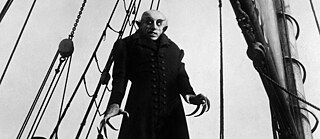Nosferatu
Almost-lost history

Friedrich Wilhelm Murnau’s 1922 silent film Nosferatu – Eine Symphonie des Grauens is not only one of the most canonical films of German Expressionist cinema, it also established one of modern horror film’s most enduring archetypes: the vampire.
By Sarah Schmidt
In creating Nosferatu, Murnau and producers Enrico Dieckmann and Albin Grau adapted Bram Stoker’s novel Dracula (1897) for the screen. Since they could not obtain the copyrights, they tried to evade censorship by simply changing the setting and names of the protagonists. Instead of London, the film takes place in the fictional German town of Wisborg. The local realtor Knock (Alexander Granach) receives a mysterious letter from a Transylvanian count and sends his young employee Thomas Hutter (Gustav von Wangenheim) on a business trip to the Carpathian mountains. Hutter’s young wife Ellen (Greta Schröder) is plagued by dark premonitions leading up to his trip, which are validated upon his arrival in Transylvania when the local residents implore Hutter not to go to the castle. Hutter ignores their warnings, making a gruesome discovery when he arrives at the castle: his host, count Orlok (Max Schreck), is a vampire who sleeps in a coffin and stalks his guest’s room at night to suck his blood. After seeing a picture of Ellen and noticing her “beautiful neck,” Orlok buys the house next-door to Hutter’s and sets sail for Wisborg. Hutter follows closely behind, but cannot prevent the impending catastrophe: upon the count’s arrival, the town is overrun by rats and beset by the plague until Ellen sacrifices herself to save the town.
When the film premiered in Berlin on March 4, 1922, World War I was still fresh in the collective memory of the Weimar republic, an experience that also left its mark on Expressionist cinema. Alongside works such as The Cabinet of Dr. Caligari (1920, Robert Wiene) and The Golem: How He Came into the World (1920, Paul Wegener), Nosferatu is one of the films that established many of the genre’s aesthetic conventions. Above all, Nosferatu is notable for its use of the expressive acting style and a strong contrast in lighting, resulting in a chiaroscuro effect, which German film critic Lotte Eisner calls, “the famous helldunkel of German cinema.”
Nosferatu deviates from other Expressionist films in its use of on-site shots of the Carpathian mountains and the High Tatras. A film like The Cabinet of Dr. Caligari uses an elaborate set in a studio to link itself to Expressionist painting with bizarre, dreamlike imagery. Nosferatu, however, uses real-world landscapes to take the viewer on a journey from the idyllic small-town life of a young married couple into an increasingly threatening countryside that foreshadows the devastation that will follow. The film’s wide shots of dark forests and rugged mountains not only refer to the aesthetic tradition of Expressionism, but also explore the genre’s roots in German Romanticism. Death is a central theme in the portrayal of Count Orlok as a cruel, tyrannical autocrat and as a more obtuse, unstoppable force of nature that controls the vampire as much as his victims.
While the film establishes many of the tropes of the modern vampire film – neck punctures, sleeping in coffins – it deviates in some aspects from both Stoker’s novel and later genre conventions: In Nosferatu, the vampire’s bite is not contagious and does not turn his victims into vampires themselves. This absence of potential immortality gives the vampire none of the seductive qualities that later incarnations of the cinematic archetype have had. Abraham van Helsing, the scientist with a penchant for the occult and Count Dracula’s main antagonist in Stoker’s novel, is reduced to a small and rather insignificant part in Nosferatu. The absence of a strong antagonist further amplifies what fuels the film’s horror, namely that rationality and science are no match for the darker forces of death and destruction that Germany and the rest of Europe experienced in World War I.
Despite these key differences from the novel, Bram Stoker’s widow still sued the producers over copyright infringements. A German court sided with her in 1925 and ordered every copy of the film in the country to be destroyed. Fortunately, one copy had already been shipped to the United States. Otherwise, this seminal piece of film history would have been lost to posterity.
author

Sarah Schmidt is a freelance journalist with a background in film and media production. She studied North American culture and literature at the Free University of Berlin and Emory University. She is currently based in Berlin. Her work focuses on transatlantic cultural exchange, film, literature, and urban politics.